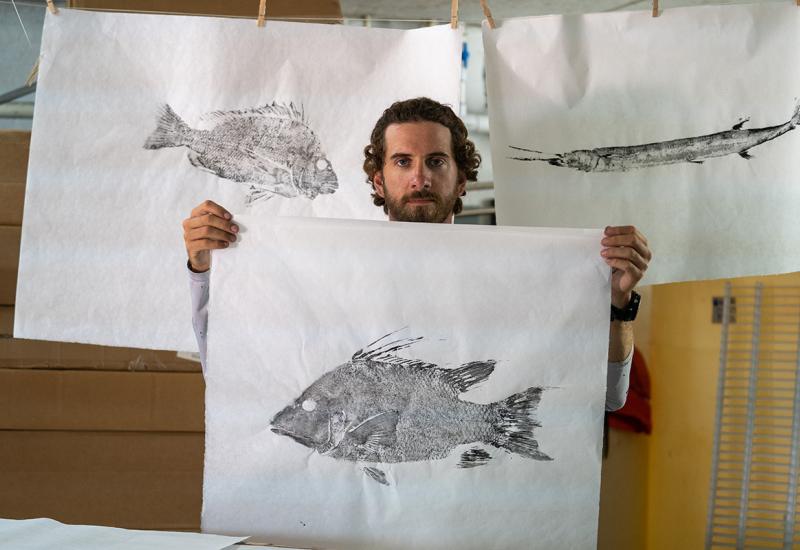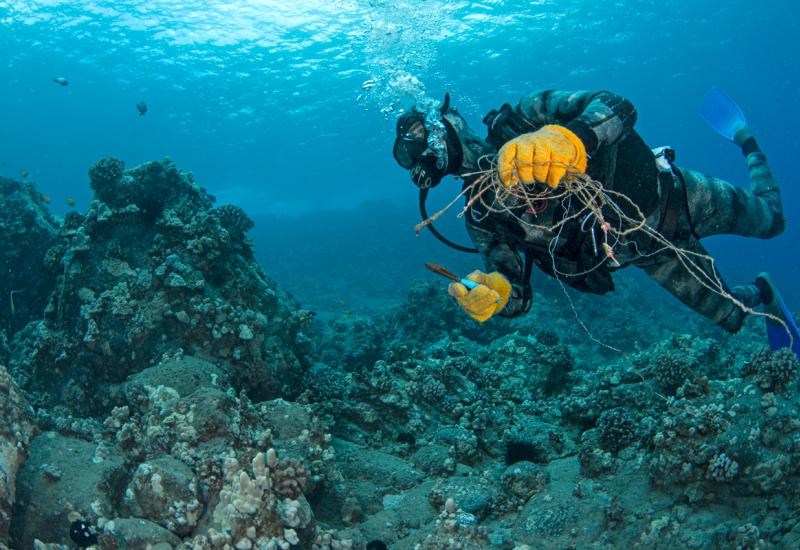What It's Like to Dive British Columbia's Unique Glass Sponge Reefs

Brandon ColeScuba diver diving Halkett Sponge Reef.
One hundred thirty feet below the surface of Howe Sound is likely as close as I will ever get to experiencing time travel. It’s not every day that one can transport back to explore primordial seas. Diving Halkett Sponge Reef in lower mainland British Columbia, Canada presents a unique opportunity to see a very rare, ancient organic reef structure scientists name a bioherm. For these ivory and buttery colored Aphrocallistes vastus glass sponges — some five feet tall resembling finely sculpted, alien underwater topiary with tubular branches adorned with fingers and lobes (called mittens), ribbing, and fluted edges — are attached not to rock but to the remains of previous generations of sponges layered beneath them embedded in glacial sediments. Commonly called cloud sponges, the eerily beautiful, fantastically shaped creatures glowing in the green gloom before us are, quite literally, anchored in history, growing from the silica-laced “bones” of their ancestors. As members of Class Hexactinellida, the tissues of these invertebrates have an internal fused skeleton of glass-like spicules made of silica.

Brandon ColeCloud sponges are fragile and long-lived, they form extensive sponge gardens or reefs in some areas that provide shelter for fish and invertebrates.
Glass sponge bioherms like this predate the dinosaurs (perhaps by hundreds of millions of years!), and were thought to have become extinct in the world's oceans about 40 million years ago. That is, until some were discovered in the late 1980s alive and well in British Columbia’s cool, productive waters. Though once widespread, extensive living sponge reefs have to date, been found nowhere else on Earth. Local diver, explorer, and citizen scientist Glen Dennison discovered Halkett’s thriving bioherm of “living fossils” off Gambier Island in Howe Sound in 1998. His self-designed, deep drop cameras and bathymetric mapping technology have also revealed a dozen additional bioherms in Howe Sound, which happens to be North America’s southernmost fjord and only an hour’s drive northwest from the bustling city of Vancouver. Most of the sponge bioherms lie in the realm of technical diving, many hundreds of feet deep and beyond — yet another reason I’ll keep saving for my own submarine — but Halkett is quite accessible, peaking at 80 feet. Experienced recreational divers breathing air, or better yet a lean mix of Nitrox, can join special charters offered by local dive operators such as Sea Dragon Charters out of Horseshoe Bay to see the cloud sponges in all their splendor.

Brandon ColeDecorated warbonnet peering out from the opening of a cloud sponge.
Marine life flourishes here. In our limited time cruising clockwise around the reef between 90 and 130 feet deep, we spot quillback rockfish, kelp greenlings, lingcod, shiner seaperch, and a variety of crustacean critters. My overactive imagination — perhaps enhanced with a touch of nitrogen narcosis — interprets the weird and wonderful sponge-scape as a field of giant melting candles or a jumble of ghostly stalagmites sprouting in a subterranean cavern. If Salvador Dali were asked to paint a sponge forest, it would look like this. I’m convinced that with more bottom time spent carefully looking into the limitless nooks and crannies formed by the numerous sponge clusters, I could observe many more fish and invertebrate species in this living habitat. For example, research teams surveying different glass sponge bioherms have documented giant Pacific octopus, spotted ratfish, and even a bluntnose sixgill shark. (How fitting that this elusive elasmobranch is nicknamed the Jurassic shark. It showcases a prehistoric body plan, legacy physiology ancestral to that of the over 500 modern shark species which have only five gill slits.)

Brandon ColeWhytecliff Park in Howe Sound, northwest of the city of Vancouver, is a popular dive site for both beginner and experienced divers. Here divers can access the glass sponge reefs from shore.
Cloud sponges can attach directly to rock substrate, growing on deep reef ridges or from the sides of steep walls. Scientists refer to the glass sponge colonies anchored to rock as sponge gardens, rather than reefs or bioherms in which live sponges are fixed to dead sponges. Glass sponge gardens are much more abundant than the bioherm structures. Two hundred feet down at a famous site called The Powerlines in Agamemnon Channel on British Columbia’s Sunshine Coast, I’ve hovered alongside huge cloud sponge masses sporting spectacular trumpet-shaped openings in which rockfish reclined. Tech divers plummet ever deeper for sponges at Snake Island out of Nanaimo. Cloud sponge can be found off Texada and Lasqueti Islands in the Strait of Georgia, and waiting in the darkness of Saanich Inlet, a glacial carved fjord on Vancouver Island. Howe Sound is glass sponge headquarters, however, where it’s even possible to dive on sponge gardens from shore. Whytecliff Park is a great place to find sponges from 90 feet down to as deep as your training will take you.
Some sponges are the size of a basketball, others as big as a small car. Some resemble puffy clouds; others look like popcorn or piles of macaroni. Careful inspection can reveal all manner of residents. Squat lobsters, spiny lithode crabs, eel-like gunnels, and decorated warbonnets hide inside sponge chambers. Fish such as greenling and lingcod deposit their egg masses between the convoluted folds. Copper and yellowtail rockfish perch on or orbit about these extraordinary oases of life.

Brandon ColeScuba divers swim over cloud sponges, a species of glass sponge which ranges from Japan and Russia across to Alaska and south to Mexico.
Marine biologists, including Dr. Jeff Marliave, PhD, a marine scientist with the Vancouver Aquarium currently involved in glass sponge research with the Howe Sound Research Program, have learned from long-term studies that glass sponge bioherms are very important ecologically, serving as key habitat, breeding and nursery grounds for a wide variety of other species, including endangered rockfish and commercially harvested halibut, herring, dungeness and tanner crabs, and spot prawns. Cloud sponges also play a vital role in water filtration, filtering bacteria from sea water and feeding on it. Collectively, nine Howe Sound sponge bioherms filter nearly 7000 Olympic swimming pools daily. Research by Marliave has shown that Aphrocallistes vastus are capable of limited regeneration, able to heal certain wounds and bounce back after heat stress, hinting that their tissues may enjoy a level of “immortality”. They really are rather extraordinary creatures, these primitive cloud sponges, especially if one considers their humble, lowly ranking on the evolutionary totem pole.
“These sponge reefs, especially the air gas diveable bioherms like Halkett, are extremely rare, much more so than coral reefs, and incredibly fragile. How well divers care for and protect these reefs will determine if they stay open for recreational diving.”
Though they’ve survived this long, at least in BC, an infinite future is by no means guaranteed for glass sponge bioherms. For a start, it is critical that divers have excellent buoyancy control and spatial awareness when surveying the Halkett site. One careless fin kick or dangling pressure gauge can do serious damage to the bioherm which geologists estimate may be 6000 to 9000 years old. Dennison comments, “These sponge reefs, especially the air gas diveable bioherms like Halkett, are extremely rare, much more so than coral reefs, and incredibly fragile. How well divers care for and protect these reefs will determine if they stay open for recreational diving.” Glass sponge bioherms are also vulnerable to destruction by fishing gear (e.g., trawling nets and prawn traps), boat anchors, the oil and gas industry, acidification, and climate change. Local diving and scientific communities are currently working together with the government to implement a suite of measures for effective protection of this truly unique ecosystem.










